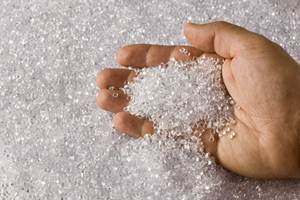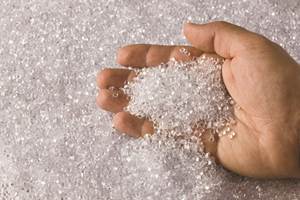High-Melt-Strength PP Makes Softer, Lighter Foams
A new high-melt-strength (HMS) polypropylene is said to be especially suited to foam extrusion because it makes much softer foams than other HMS-PP grades.
A new high-melt-strength (HMS) polypropylene is said to be especially suited to foam extrusion because it makes much softer foams than other HMS-PP grades. It also produces very low densities and good mechanical properties.
Designed especially for “direct gassing” with butane or CO2, the new HMS-PP produces foam densities from 0.03 to 0.250 g/cc, useful for food and protective packaging, automotive seating and impact cushioning, and sports shoes. It also looks very promising for structural foam injection molding.
New Daploy WB260HMS from Borealis A/S of Denmark is available here from Transmit Technology Group, Borealis’ North American representative for HMS-PP. It offers some improvements over another grade of HMS-PP from Borealis, Daploy WB130HMS, which has been on the market for two years and provides similar overall performance. Initial sampling and technical support for both HMS-PP grades is being handled in the U.S. by Transmit Technology Group. According to the company’s president, Amit Dharia, the new materials can compete in foam applications traditionally dominated by crosslinked PE, polyurethane, and PVC.
He notes that once a customer is ready to use Daploy materials on a commercial scale (greater than 22,500 lb), order processing will then be performed directly by Borealis’ export customer-service office in Belgium.
| INJECTION MOLDING WITH CHEMICAL BLOWING AGENT | |||
% HMS-PP | 0 | 10 | 20 |
% PP Homopol. (30 MI) | 100 | 90 | 80 |
Density, g/cc | 0.751 | 0.654 | 0.580 |
Ult. Tens. Str., psi | 3693 | 3788 | 4153 |
Ult. Elongation, % | 5.5 | 5.6 | 9.0 |
| Notched Izod Impact, ft-lb/in. | 0.4 | 0.43 | 0.43 |
Foam extrusion
Borealis’ HMS-PP is said to combine significantly increased melt strength—due its long-chain branching—with greatly improved melt elasticity. The result is improved processability in processes where stretching flows occur, such as in extrusion foaming, blow molding, and thermoforming.
Most current PP foams are based on blends of 30% to 50% HMS-PP (from sources such as Basell or Dow) with standard PP and an impact modifier such as a metallocene polyolefin elastomer (POE). Daploy WB260HMS and WB130HMS have similar MFR (2.5 and 2.1, respectively) but WB260 has three times higher room-temperature impact strength (3 vs. 8 kJ/m2), and half the flexural modulus (1000 vs. 2000 MPa) of WB130.
The lower stiffness, higher resiliency, and greater toughness of WB260 mean less impact modifier is required in a formulation. That is beneficial because POE modifiers can hinder foaming and make lower density foams difficult to achieve, according to Dharia.
WB260HMS has a lower melting point of 142 C, compared with 162 C for typical PP. Lower melting point allows use of blowing agents with lower decomposition temperatures. Lower extrusion temperatures facilitate making lower-density foams.
Extruded foam samples were made recently for a potential customer using isobutane as a blowing agent in blends of 70% PP (Daploy and a standard PP) and 30% metallocene POE modifier. Says Dharia, “We were able to achieve densities as low as 0.03 g/cc. Because of the lower stiffness of WB260, we required only 30% POE versus 50% with WB130 to achieve similar softness. Also, since we extrude WB260 at much lower temperature—as low as 280 F in some cases—than WB130, we were able to make lighter foam, which required less cooling.”
In TPO and TPV foams, HMS-PP permits achieving lower densities. Other mechanical properties can be tailored by blending HMS-PP with standard PP resins, explains Dharia. “For example, block copolymer can be used to increase toughness, random copolymer to decrease stiffness, and mLLDPE can be added as a modifier to make very soft foams.”
Structural foams
Daploy WB260 has also been evaluated in structural foam injection molding. Says Dharia, “We have demonstrated how the addition of WB260HMS-PP improves properties of foamed PP.” In one test, 5 phr of a chemical blowing agent concentrate containing 20% active ingredient was dryblended with mixes of standard PP with WB260HMS. Blends were injection molded into 0.25-in.-thick bars at 410 F. As shown in the table on p. 43, higher levels of HMS-PP reduced density while increasing tensile strength, elongation, and impact strength.
In an early commercial experiment, large pet houses were injection molded from dryblends of a 30-MFR, talc-filled PP copolymer plus 10% and 20% WB130 and a chemical blowing agent. The addition of HMS-PP reduced the foam density so that the part weight dropped from 21 lb to 19.8 lb, while the overall cycle time was reduced from 114 sec to 80 sec. The molded pet houses showed higher gloss and no gas-flow marks. Although shrinkage was higher, the product passed the customer’s quality-control test, according to Dharia.
Related Content
Prices Up for PE, PP, PS, Flat for PVC, PET
Trajectory is generally flat-to-down for all commodity resins.
Read MoreApril 2025: Mixed Bag for Prices of Volume Resins
The end of the first quarter marked higher prices for polyolefins and relatively flat pricing for nearly all other resins.
Read MoreFundamentals of Polyethylene – Part 3: Field Failures
Polyethylene parts can fail when an inappropriate density is selected. Let’s look at some examples and examine what happened and why.
Read MorePrices Drop for All Five Commodity Resins
While PE price reductions were not as apparent, they too were following the year-end price trajectory of PP, PS, PVC and PET.
Read MoreRead Next
People 4.0 – How to Get Buy-In from Your Staff for Industry 4.0 Systems
Implementing a production monitoring system as the foundation of a ‘smart factory’ is about integrating people with new technology as much as it is about integrating machines and computers. Here are tips from a company that has gone through the process.
Read MoreBeyond Prototypes: 8 Ways the Plastics Industry Is Using 3D Printing
Plastics processors are finding applications for 3D printing around the plant and across the supply chain. Here are 8 examples to look for at NPE2024.
Read MoreFor PLASTICS' CEO Seaholm, NPE to Shine Light on Sustainability Successes
With advocacy, communication and sustainability as three main pillars, Seaholm leads a trade association to NPE that ‘is more active today than we have ever been.’
Read More












